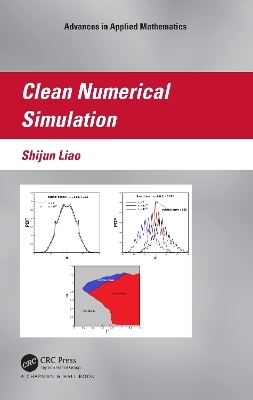
Clean Numerical Simulation
Chapman & Hall/CRC (Verlag)
978-1-032-28809-3 (ISBN)
This book describes the basic principles of Clean Numerical Simulation (CNS) proposed by the author in 2009, as well as several of its applications. Unlike conventional algorithms, CNS gives in a sufficiently long interval of time a convergent chaotic trajectory whose numerical noise is much lower than the true physical solution, so that one can gain accurately. Thus, CNS provides for the first time an ability to check statistics stability of chaos, leading to a completely new concept of "ultra-chaos," which has both trajectory instability and statistics instability, and thus is of a higher disorder.
Notably, it is impossible to repeat experimental results of ultra-chaos even in the statistical sense. However, the reproducibility of physical experiments forms a cornerstone for modern science. Thus, ultra-chaos reveals an incompleteness of the modern science paradigm. In addition, it also reveals statistics stability as a precondition for use of conventional algorithms, including direct numerical simulation (DNS). In Clean Numerical Simulation, several conjectures and open problems are proposed, including a modified fourth Clay millennium problem.
Indeed, CNS opens the door for us to enter the "clean" numerical world of chaos and turbulence.
Shijun Liao is Chun-Shen Distinguished Professor, Director, State Key Laboratory of Ocean Engineering, and Dean, School of Naval Architecture, Ocean and Civil Engineering at Shanghai Jiao Tong University, Shanghai, China. He holds a Ph.D. from Shanghai Jiao Tong University. he is also Cheung-Kong Distinguished Professor (Ministry of Education of China). His research is well-known. Topics include Nonlinear mechanics, gravity waves, turbulence, nonlinear dynamics, chaos, applied mathematics, analytic approximation method for highly nonlinear equations, reliable numerical simulations of chaotic systems and turbulence, and computer algebra methods in nonlinear mechanics. Awards and honors include Shanghai Scientific Elite (2017), National Natural Science Award (2016), Shanghai Natural Science Award (2009), Shanghai Peony Natural Science Award (2009), Shanghai Excellent Teaching Award (2004), Thomson Reuters Highly Cited Researcher in mathematics (2014, 2015, 2016), Thomson Reuters Highly Cited Researcher in engineering (2014), World’s Top 2% Scientists 2020 (Stanford University). He is also the author of Beyond Perturbation: Introduction to the Homotopy Analysis Method, also published by CRC Press.
1 Introduction. 2. CNS algorithms for temporal chaos. 3. CNS algorithms for spatio-temporal chaos. 4. On the origin of macroscopic randomness. 5. Ultra-chaos: a higher disorder than normal-chaos. 6. Numerical simulation of turbulence: true or false? 7. Periodic orbits of the three-body problem.
| Erscheinungsdatum | 27.10.2023 |
|---|---|
| Reihe/Serie | Advances in Applied Mathematics |
| Zusatzinfo | 40 Halftones, color; 2 Halftones, black and white; 40 Illustrations, color; 2 Illustrations, black and white |
| Sprache | englisch |
| Maße | 156 x 234 mm |
| Gewicht | 880 g |
| Themenwelt | Mathematik / Informatik ► Mathematik ► Analysis |
| Naturwissenschaften ► Physik / Astronomie | |
| Technik ► Umwelttechnik / Biotechnologie | |
| ISBN-10 | 1-032-28809-4 / 1032288094 |
| ISBN-13 | 978-1-032-28809-3 / 9781032288093 |
| Zustand | Neuware |
| Haben Sie eine Frage zum Produkt? |
aus dem Bereich


